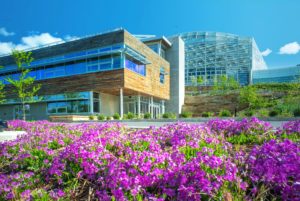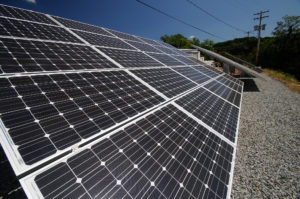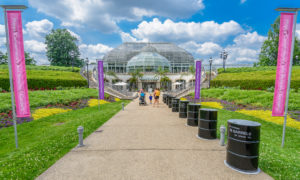I once heard a statistic that said that if everyone in the world lived the way we do in the U.S., it would take five planets worth of natural resources to do so. This is obviously impossible. Our unsustainable lifestyles are the root cause of such environmental issues as climate change, air pollution, reduced availability of clean water and the persistent toxic chemicals that threaten human, animal and environmental health and well-being. People in rapidly developing countries worldwide aspire to live like we do in the West. A reinvention of the way we live is necessary to make it possible for everyone in the world to lead a better life and make sustainable living the model we export to the rest of the world.
Net-zero energy buildings, as demonstrated by the many projects documented by the New Buildings Institute and the International Living Future Institute, can play a key role in this reinvention, bringing together cutting-edge technology and design to create dynamic spaces that are as inviting and purposeful as they are efficient. Even more importantly, they can dispel the myth that sustainability isn’t uncomfortable or wholly focused on sacrifice, instead showing the ways that sustainability is beautiful, intelligent and aspirational.

At Phipps Conservatory and Botanical Gardens — a 125-year-old Victorian glasshouse and garden in Pittsburgh, PA — we’ve expanded our efforts over time to make our campus a leader in net zero energy buildings, green energy and sustainable programs and research. As part of these efforts, we have exceeded the Paris Climate Agreement goals, reducing the carbon dioxide emissions from our buildings by 56% per square foot since 2005.
Our green evolution began with our buildings, because the built environment is responsible for approximately 40% of the energy we use and pollution we produce. In 2005, Phipps opened the first LEED®-certified visitor center in a public garden. The following year, we constructed the first and only LEED®-certified production greenhouse (Platinum EBOM) and one of the most energy efficient conservatories, a 12,000-square-foot glasshouse that has no greenhouse effect, is 100% passively cooled and remains cooler inside than outside in the summer.

In 2012, Phipps opened the Center for Sustainable Landscapes (CSL), the first and only facility in the world to meet four of the highest green building standards: Living Building Challenge™, WELL Building Platinum, Four-Stars Sustainable SITES™ and LEED® Platinum. The CSL generates all its own energy through 125KW of on-site photovoltaics, captures and treats all of its storm and sanitary water, and is free from toxic chemicals. It was joined by the modular net-zero energy Nature Lab at Phipps in 2015. Phipps is working on its third net-zero energy building, a renovation of a former public works building as an Exhibit Staging Center. The CSL will soon be the centerpiece of a Living Campus showcasing a dynamic spectrum of net-zero energy projects — new, modular and renovation — all on asingle site.
Constructing net-zero energy buildings is just one dimension of impact, though. The more significant impact comes with the chance to show hundreds of thousands of visitors each year that green healthy places can be better than the places we live, work, play and learn in now. After having worked in the CSL for the past five years, I would never want to work in a conventional building, and I’ve heard from countless employees who share this opinion. We no longer need to wait for a greener future; we have the technology and capacity to build buildings like this today, and Phipps helps people realize that they should demand more from their buildings too.

What began with our buildings extended to operations and more, as Phipps has taken a holistic, systems-based approach to refining its standards. Since 2005, 100% of campus electricity has been produced on-site with solar and wind or offset by renewable energy credits. All carbon produced to heat our facilities is offset with carbon credits. Our horticulture program focuses on organic principles, minimizing the need for fossil fuel based fertilizers and pesticides. All energy sector investments in our portfolio have been reinvested in renewable energy. Our café features local and organic produce, has eliminated hormones, antibiotics and nitrates from meats; eliminated plastic disposable serviceware, bottled water, soda and junk food; composts all pre- and post-consumer waste; and uses humanely raised animal products and rBST-free dairy products.

Recently we have focused on finding ways to help our visitors adopt more sustainable lifestyles. In January 2017 we forged an agreement with a renewable electricity provider to purchase discounted Phipps memberships as incentives for visitors to switch their home electricity to renewable energy. Because nobody knows what a ton of CO2 looks like, we lined our entrance with 16 oil barrels to demonstrate that if burned they would emit the same amount of CO2 a typical household produces to power their home each year. The results are phenomenal. In the first 12 months, over 2,500 families switched, and those 16 barrels of oil not burnt each year are now more than 42,000. And these very same guests, who turned to Phipps to learn what they should do next, inspired Easy Steps with Big Impact for Climate Change, a new resource with ten actions specially prepared by Phipps for maximum climate impact at home.
In 2018, Phipps held its first Sustainability Training Workshop for professionals interested in building more sustainably, and its second annual One Health One Planet™ conference, which unites thought leaders from disparate fields in the environmental and health sciences to forge a shared interdisciplinary definition of health.
Through all these efforts, whether at the public or professional level, locally or nationally, we hope to inspire and support a greener lifestyle for all those who care about the planet.
by Richard V. Piacentini, Executive Director, Phipps Conservatory and Botanical Gardens
